Introduction: Cheap, Easy Light Probe
I teach high school physics and I use a lot of expensive probeware to collect data. The only reason I can do this is my school has been collecting the probes over a number of years, building our collection slowly over time. For those who aren't science teachers, probeware refers to a collection of interfaces used to connect a variety of sensors to a computer or graphing calculator. These interfaces can allow for real time data collection and graphing or can serve as data-loggers collecting data over time.
The two largest vendors of educational probeware are Vernier and Pasco:
-http://www.vernier.com/
-http://www.pasco.com/
Not every school has the ability/money to do probeware based labs, however. So, here is a description of how to create a really simple probe that will allow you to see the fluctuations in light caused by alternating current or see the signal from a TV remote control (as well as do other things I'll describe in a future Instructable).
Total cost is less than $5, but you need a computer with an oscilloscope program installed.
Visual Analyser - Free oscilloscope program for Windows. http://www.sillanumsoft.com/
Audacity - Can be used as a recording oscilloscope. http://audacity.sourceforge.net/
Step 1: What Do You Need?
Tools:
-Wire Cutters/Strippers
-Soldering Iron
Materials:
-Cheap Solar Cell (I bought mine for $3)
-Headphones from the Dollar Store (you could just buy a microphone plug and some wire)
-Alligator Leads (I used red and black, but you can use any color)
-Electrical Tape (heat shrink tubing would be cooler, but I'm lazy and cheap)
Step 2: Destroy the Headphones
Cut one of the earphone off and carefully strip back the wire. You'll notice some strands of wire. One will be a different color (red or blue). Separate the colored strand from the others.
The colored strand carries the signal while the other strands are the common ground. You'll need to strip off the insulation. There are two ways of doing this. You can lightly sand the wire, but you risk breaking it, or you can burn it off. The enamel will burn off readily, but if you burn it too long the wire will melt.
Step 3: Destroy the Aligator Leads
Cut your alligator leads in half and strip the ends. I used two leads, but you could get away with one if you don't mind each side being the same color.
Step 4: Put It Together
Now all you need to do is attach your alligator leads to the headphones. I put the black lead on the common ground (the loose strands or wire) and the red wire on the signal wire (the single colored wire).
Be very careful not to break the signal wire. It's very thin and fairly easy to snap.
Solder it together.
Step 5: Hide Your Mistakes With Electrical Tape
Now wrap the two wires separately with electrical tape and then wrap them together for strength. The added bonus with the headphones I bought is the cassette tape holder. I now have a handy box to store my wires in.
Step 6: Using It.
Attach the alligator clips to the solar cell and plug it into the microphone jack on your computer. Turn on your oscilloscope program or hit record in Audacity. Then you point the solar cell at any light that is changing. If you're using Audacity, you'll have to zoom in to see anything (see the pictures below).
You could solder the wires directly to the solar cell, but I typically don't. This way I can use my probe with any varying voltage source. Just be careful to keep the voltage low so you don't fry your sound card.
I've done some digging (after some comments, thanks) and found a reference to a 2Vpp voltage limit on a SoundBlaster AWE64 Audio Card. You should probably check your solar cell to determine it's maximum output. If you're concerned it would be a simple matter to include a current limiting resistor. The solar cells I've used are rated for a maximum of 0.5 V and I've had no problems so far.
Reference: http://www.ece.msstate.edu/~hagler/May2001/15/BEGIN.HTM
Examples:
-Any light plugged into alternating current
-Your computer monitor (frequency will equal refresh rate)
-TV remote control. The solar cell should pick up the IR.
Participated in the
The Instructables Book Contest













